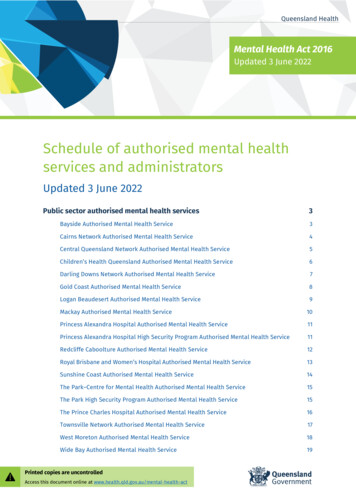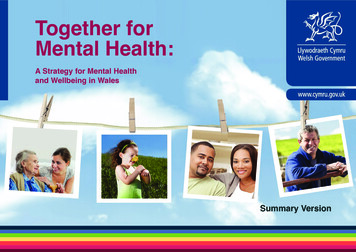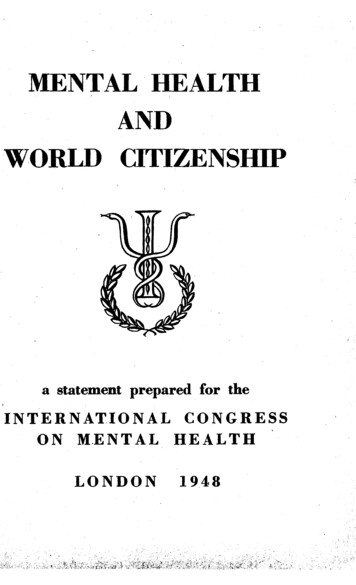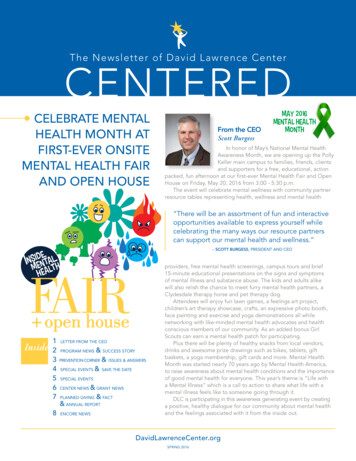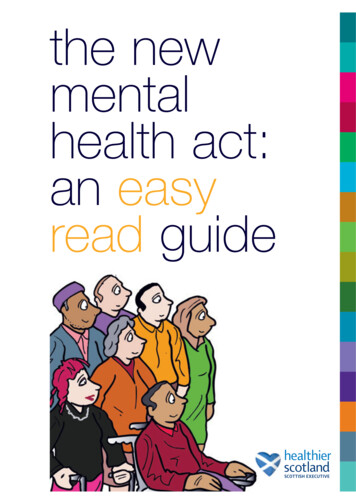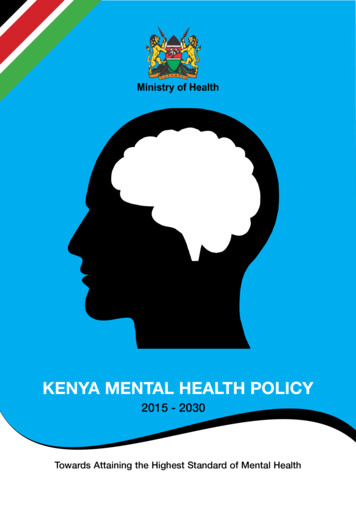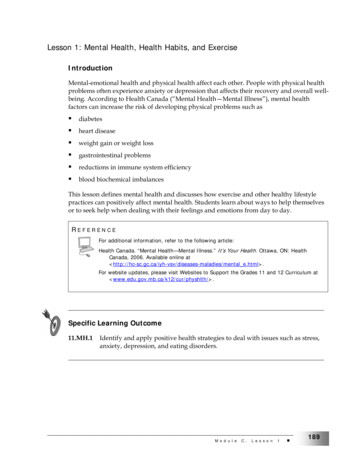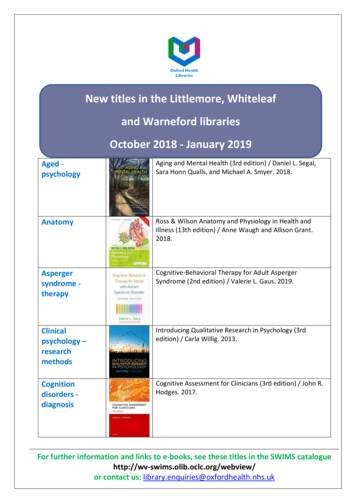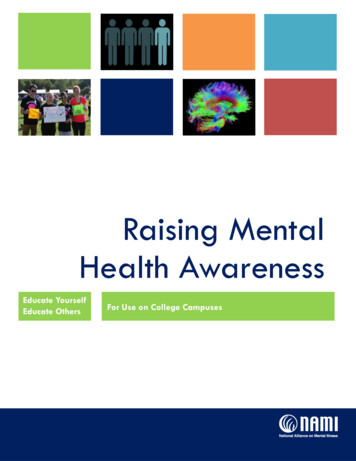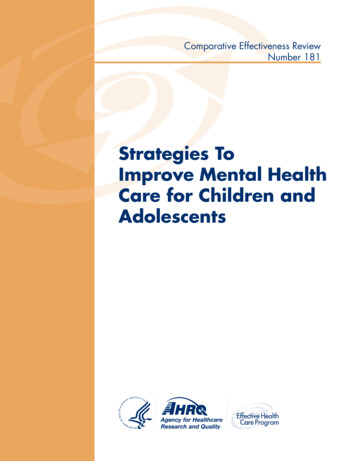
Transcription
Comparative Effectiveness ReviewNumber 181Strategies ToImprove Mental HealthCare for Children andAdolescentse
Comparative Effectiveness ReviewNumber 181Strategies To Improve Mental Health Care for Childrenand AdolescentsPrepared for:Agency for Healthcare Research and QualityU.S. Department of Health and Human Services5600 Fishers LaneRockville, MD 20857www.ahrq.govContract No. 290-2012-00008-IPrepared by:RTI International–University of North Carolina Evidence-based Practice CenterResearch Triangle Park, NCInvestigators:Valerie L. Forman-Hoffman, Ph.D., M.P.H.Jennifer Cook Middleton, Ph.D.Joni Lynn McKeeman, Ph.D.Leyla Faw Stambaugh, Ph.D.Robert Bourke Christian, M.D., FAAPBradley Neil Gaynes, M.D., M.P.H.Heather Lynne Kane, Ph.D.Leila C. Kahwati, M.D., M.P.H.Kathleen N. Lohr, Ph.D.Meera Viswanathan, Ph.D.AHRQ Publication No. 16(17)-EHC035-EFDecember 2016
This report is based on research conducted by the RTI International–University of NorthCarolina Evidence-based Practice Center (EPC) under contract to the Agency for HealthcareResearch and Quality (AHRQ), Rockville, MD (Contract No. 290-2012-00008-I). The findingsand conclusions in this document are those of the authors, who are responsible for its contents;the findings and conclusions do not necessarily represent the views of AHRQ. Therefore, nostatement in this report should be construed as an official position of AHRQ or of the U.S.Department of Health and Human Services.None of the investigators have any affiliations or financial involvement that conflicts withthe material presented in this report.The information in this report is intended to help health care decisionmakers—patients andclinicians, health system leaders, and policymakers, among others—make well-informeddecisions and thereby improve the quality of health care services. This report is not intended tobe a substitute for the application of clinical judgment. Anyone who makes decisions concerningthe provision of clinical care should consider this report in the same way as any medicalreference and in conjunction with all other pertinent information, i.e., in the context of availableresources and circumstances presented by individual patients.This report is made available to the public under the terms of a licensing agreement between theauthor and the Agency for Healthcare Research and Quality. This report may be used andreprinted without permission except those copyrighted materials that are clearly noted in thereport. Further reproduction of those copyrighted materials is prohibited without the expresspermission of copyright holders.AHRQ or U.S. Department of Health and Human Services endorsement of any derivativeproducts that may be developed from this report, such as clinical practice guidelines, otherquality enhancement tools, or reimbursement or coverage policies, may not be stated or implied.This report may periodically be assessed for the currency of conclusions. If an assessment isdone, the resulting surveillance report describing the methodology and findings will be found onthe Effective Health Care Program Web site at www.effectivehealthcare.ahrq.gov. Search on thetitle of the report.Persons using assistive technology may not be able to fully access information in this report. Forassistance contact EffectiveHealthCare@ahrq.hhs.gov.Suggested citation: Forman-Hoffman VL, Cook Middleton J, McKeeman JL, Stambaugh LF,Christian RB, Gaynes BN, Kane HL, Kahwati LC, Lohr KN, Viswanathan M. Strategies ToImprove Mental Health Care for Children and Adolescents. Comparative Effectiveness ReviewNo. 181. (Prepared by the RTI International–University of North Carolina Evidence-basedPractice Center under Contract No. 290-2012- 00008-I.) AHRQ Publication No. 16(17)EHC035-EF. Rockville, MD: Agency for Healthcare Research and Quality; December l.cfm.ii
PrefaceThe Agency for Healthcare Research and Quality (AHRQ), through its Evidence-basedPractice Centers (EPCs), sponsors the development of systematic reviews to assist public- andprivate-sector organizations in their efforts to improve the quality of health care in the UnitedStates. These reviews provide comprehensive, science-based information on common, costlymedical conditions, and new health care technologies and strategies.Systematic reviews are the building blocks underlying evidence-based practice; they focusattention on the strength and limits of evidence from research studies about the effectiveness andsafety of a clinical intervention. In the context of developing recommendations for practice,systematic reviews can help clarify whether assertions about the value of the intervention arebased on strong evidence from clinical studies. For more information about AHRQ EPCsystematic reviews, see .cfm.AHRQ expects that these systematic reviews will be helpful to health plans, providers,purchasers, government programs, and the health care system as a whole. Transparency andstakeholder input are essential to the Effective Health Care Program. Please visit the Web site(www.effectivehealthcare.ahrq.gov) to see draft research questions and reports or to join anemail list to learn about new program products and opportunities for input.If you have comments on this systematic review, they may be sent by mail to the Task OrderOfficer named below at: Agency for Healthcare Research and Quality, 5600 Fishers Lane,Rockville, MD 20857, or by email to epc@ahrq.hhs.gov.Andrew Bindman, M.D.DirectorAgency for Healthcare Research and QualityArlene S. Bierman, M.D., M.S.DirectorCenter for Evidence and PracticeImprovementAgency for Healthcare Research andQualityStephanie Chang, M.D., M.P.H.DirectorEvidence-based Practice Center ProgramCenter for Evidence and Practice ImprovementAgency for Healthcare Research and QualityChristine Chang, M.D., M.P.H.Task Order OfficerCenter for Evidence and PracticeImprovementAgency for Healthcare Research andQualityiii
AcknowledgmentsThe authors gratefully acknowledge the following individuals for their contributions to thisproject and deeply appreciate their considerable support, commitment, and contributions:Christine Chang, M.D., M.P.H., our AHRQ Task Order Officer; Denise Dougherty, Ph.D.,AHRQ Senior Advisor; Charlotte Mullican, M.P.H., AHRQ Senior Advisor; Richard A. Epstein,Ph.D., M.P.H., our Associate Editor; RTI International–University of North Carolina EPCstaff—Carol Woodell, B.S.P.H., EPC Project Manager; Daniel Jonas, M.D., M.P.H., EPC CoDirector; Christiane Voison, M.S.L.S., Librarian; Heather Ringeisen, Ph.D., Scientific Reviewer;Emmanuel Coker-Schwimmer, M.P.H., research assistant; Catherine Grodensky, M.P.H.,research assistant; Claire Baker, B.S., research assistant; Sharon Barrell, M.A., editor; LauraSmall, B.A., editor; and Loraine Monroe, publications specialist.Key InformantsIn designing the study questions, the EPC consulted several Key Informants who representthe end-users of research. The EPC sought the Key Informant input on the priority areas forresearch and synthesis. Key Informants are not involved in the analysis of the evidence or thewriting of the report. Therefore, in the end, study questions, design, methodological approaches,and/or conclusions do not necessarily represent the views of individual Key Informants.Key Informants must disclose any financial conflicts of interest greater than 10,000 and anyother relevant business or professional conflicts of interest. Because of their role as end-users,individuals with potential conflicts may be retained. The TOO and the EPC work to balance,manage, or mitigate any conflicts of interest.The list of Key Informants who provided input to this report follows:Kenneth S. Fink, M.D., M.G.A., M.P.H.Med-QUEST Division, State of HawaiiDepartment of Human ServicesKapolei, HIKelly Kelleher, M.D., M.P.H.The Research Institute at NationwideChildren’s HospitalColumbus, OHDarcy Gruttadaro, J.D.National Alliance on Mental IllnessArlington, VABryan Samuels, M.P.P.Chapin Hall Center for Children at theUniversity of ChicagoChicago, ILKimberly Eaton Hoagwood, Ph.D.Department of Child and AdolescentPsychiatryNew York UniversityNew York, NYMark Weist, Ph.D.Department of PsychologyUniversity of South CarolinaColumbia, SCLouise Johnson, M.S.Division of Children, Adolescents and TheirFamiliesSouth Carolina Department of MentalHealthColumbia, SCiv
Technical Expert PanelIn designing the study questions and methodology at the outset of this report, the EPCconsulted several technical and content experts. Broad expertise and perspectives were sought.Divergent and conflicted opinions are common and perceived as healthy scientific discourse thatresults in a thoughtful, relevant systematic review. Therefore, in the end, study questions, design,methodologic approaches, and/or conclusions do not necessarily represent the views ofindividual technical and content experts.Technical Experts must disclose any financial conflicts of interest greater than 10,000 andany other relevant business or professional conflicts of interest. Because of their unique clinicalor content expertise, individuals with potential conflicts may be retained. The TOO and the EPCwork to balance, manage, or mitigate any potential conflicts of interest identified.The list of Technical Experts who provided input to this report follows:Jeffrey A. Buck, Ph.D.*Center for Clinical Standards & QualityCenters for Medicare & Medicaid ServicesBaltimore, MDKelly Kelleher, M.D., M.P.H.*The Research Institute at NationwideChildren’s HospitalColumbus, OHKimberly Eaton Hoagwood, Ph.D.Department of Child and AdolescentPsychiatryNew York UniversityNew York, NYMichael P. Kelly, Ph.D., Hon FRCP,FRCPE, FFPH*Institute of Public HealthUniversity of CambridgeCambridge, UKAaron T. Hogue, Ph.D.National Center on Addiction and SubstanceAbuseNew York, NYDouglas K. Novins, M.D.*Division of Child & Adolescent PsychiatryDepartment of PsychiatryUniversity of Colorado School of MedicineAurora, COLouise Johnson, M.S.Division of Children, Adolescents and TheirFamiliesSouth Carolina Department of MentalHealthColumbia, SC*Provided input on Draft Report.v
Peer ReviewersPrior to publication of the final evidence report, EPCs sought input from independent PeerReviewers without financial conflicts of interest. However, the conclusions and synthesis of thescientific literature presented in this report do not necessarily represent the views of individualreviewers.Peer Reviewers must disclose any financial conflicts of interest greater than 10,000 and anyother relevant business or professional conflicts of interest. Because of their unique clinical orcontent expertise, individuals with potential nonfinancial conflicts may be retained. The TOOand the EPC work to balance, manage, or mitigate any potential nonfinancial conflicts of interestidentified.The list of Peer Reviewers follows:Embry Howell, Ph.D.The Urban Institute, Health Policy CenterWashington, DCMarc S. Atkins, Ph.D.Departments of Psychiatry and PsychologyInstitute for Juvenile ResearchDissemination and Implementation Researchand Policy ProgramUIC Center for Clinical TranslationalScienceUniversity of Illinois at ChicagoChicago, ILMark Weist, Ph.D.Department of PsychologyUniversity of South CarolinaColumbia, SCLeonard Bickman, Ph.D.Psychological SciencesVanderbilt UniversityNashville, TNTumani Coker, M.D., M.B.A.Assistant Professor of Pediatrics, DavidGeffen School of Medicine and MattelChildren's Hospital at UCLAAssociate Director of Health ServicesResearch, UCLA Children's Discovery andInnovation InstituteNatural Scientist, RANDLos Angeles, CAvi
Strategies To Improve Mental Health Care for Childrenand AdolescentsStructured AbstractObjectives. To assess the effectiveness of quality improvement, implementation, anddissemination strategies that seek to improve the mental health care of children and adolescents;to examine harms associated with these strategies; and to determine whether effectiveness orharms vary in subgroups based on system, organizational, practitioner, or patient characteristics.Data sources. Searches from inception through January 14, 2016, of MEDLINE , CochraneLibrary, PsycINFO , CINAHL (Cumulative Index to Nursing and Allied Health Literature),and gray literature; additional studies from reference lists and study authors.Review methods. Dual selection, data extraction, and risk of bias assessment of relevanttrials and observational studies, followed by analysis, synthesis, and grading the strength ofevidence for each outcome. We also employed qualitative comparative analysis (QCA) toexamine set relationships between combinations of strategy components and improvements inoutcomes.Results. We found 17 studies testing overall effectiveness of 16 strategies, of which 1reported on harms and 4 on moderators of effectiveness. The evidence base includes 13randomized controlled trials (RCTs), 2 controlled clinical trials, 1 cohort, and 1 interrupted timeseries. The strategies included in this review were complex and heterogeneous. We found 7studies (6 strategies) that comprised only professional components and 10 studies (10 strategies)that consisted of one or more financial or organizational components, although many of theseincluded professional components as well. Twelve studies included multiple active components;5 had a single active component.We found evidence that a majority of strategies had at least some evidence of effectiveness.Twelve studies (11 strategies) had at least one outcome rated as low for benefit. We graded thestrength of evidence of one outcome for one strategy as moderate: one RCT reported thatprovider financial incentives improve practitioner implementation competence. Our QCArevealed inconsistent evidence on strategies with educational meetings, materials, and outreach:these strategies appeared to be successful in combination with reminders or providingpractitioners with newly collected clinical information. We also found low strength of evidenceof no benefit for strategies that included educational materials only, educational meetings only,educational materials and meetings only, and educational materials and outreach componentsonly.We were unable to judge the overall potential for harms associated with these strategies thatmay mitigate benefits based on the single included study with information on harms. Theavailable evidence from four studies on two moderators does not permit us to make generalconclusions about the conditions under which these strategies might work optimally.Conclusions. Our findings suggest that several approaches can improve both intermediateand final health outcomes and resource use. Twelve of the 17 included studies (11 of the 16strategies) significantly improved at least one such outcome or measure. The evidence does notpermit us to have a high degree of confidence about the efficacy of any one strategy because wegenerally found a single study testing each strategy. We found inconsistent evidence involvingstrategies with educational meetings, materials, and outreach; programs appeared to besuccessful in combination with reminders or providing practitioners with newly collected clinicalvii
information. We also found low strength of evidence for no benefit for initiatives that includedonly educational materials or meetings (or both) or only educational materials and outreachcomponents.viii
ContentsExecutive Summary . ES-1Introduction . 1Background .1Condition .1Strategies To Improve Mental Health in Children .1Potential Moderators of Strategy Effectiveness .2Scope and Key Questions .3Rationale for Evidence Review .3Proposed Contributions to the Evidence Base .3Scope of the Review .3Key Questions .4Analytic Framework .4Organization of This Report .5Methods . 6Topic Refinement and Protocol Review .6Literature Search Strategy.6Search Strategy .6Inclusion and Exclusion Criteria.7Moderators .11Study Selection .11Data Extraction .12Risk of Bias Assessment .12Data Synthesis .12Strength of the Body of Evidence .13Applicability .14Peer Review and Public Commentary .14Additional Analyses in Response to Peer Review and Public Commentary .15Searches for Related Publications .15Outreach to Authors .15Qualitative Comparative Analysis .15Results . 17Introduction .17Description of Included Studies .19Key Question 1. Effectiveness of Strategies .26Key Points: Characterization of Strategies .27Intermediate Outcomes .28Key Points: Patient Health and Service Utilization Outcomes .28Key Points: Qualitative Comparative Analysis Findings .29Detailed Synthesis .29Finding Recipes for Success .65Inputs.65Models.66Solutions .66Key Question 2: Harms .68Key Points .68ix
Detailed Study Description .68Conclusion and Strength of Evidence .69Key Question 3: Moderators .69Key Points .69Detailed Study Description .70Discussion. 75Key Findings and Strength of Evidence .75Key Question 1. Effectiveness of Strategies To Improve Mental Health Care forChildren and Adolescents .75Key Question 2. Harms Associated With Strategies To Improve Mental Health Carefor Children and Adolescents.91Key Question 3. Moderators of the Effectiveness of Strategies To Improve MentalHealth Care for Children and Adolescents .91Finding Solutions for Success .94Findings in Relationship to What Is Already Known .95Applicability .96Population .96Interventions and Comparators .97Outcomes .97Settings .97Implications for Clinical and Policy Decisionmaking .97Limitations of the Systematic Review Process .99Limitations of the Evidence Base .100Contributions of Novel Analytic Approaches to Addressing Complex Interventions inSystematic Reviews .102Contributions From Searches of Related Publications .102Contributions From Outreach to Investigators .103Contribution From Qualitative Comparative Analysis .103Research Recommendations .103Conclusions .106References . 108TablesTable A. Definitions of the grades of overall strength of evidence . ES-6Table B. Strategies to improve mental health of children and adolescents: Studycharacteristics . ES-9Table C. Strategies to improve mental health of children and adolescents: Summary table . ES-10Table 1. Inclusion/exclusion criteria for strategies to improve mental health services forchildren and adolescents . 7Table 2. Definitions of the grades of overall strength of evidence . 13Table 3. Summary table of strategies tested . 21Table 4. Strategies to improve mental health of children and adolescents: Studycharacteristics . 26Table 5. Intermediate and patient health and service utilization outcomes by primarycomponent of strategy . 27Table 6. Adding an active learning component to a professional training workshop toimplement an EBP: Summary of results . 31x
Table 7. Training nurses to educate parents about EBPs: Summary of results . 34Table 8. Training practitioners to identify and refer cases: Summary of results . 36Table 9. Training practitioners with or without feedback to implement an EBP: Summary ofresults . 39Table 10. Training practitioners to use an MMTP: Summary of results . 40Table 11. Adding computer-assisted training with or without ongoing supervision andcoaching to practitioners implementing an EBP: Summary of results . 42Table 12. Providing practitioner access to practice guidelines via an Internet portal:Summary of results . 45Table 13. Adding weekly feedback to practitioners regarding patient symptoms andfunctioning: Summary of results . 47Table 14. Adding diagnosis and treatment guidelines to a computer decision support system:Summary of results . 49Table 15. Adding IQA to implement an EBP: Summary of results. 51Table 16. Collaborative consultation to promote the use of titration trials and periodicmonitoring during medication management: Summary of results . 53Table 17. Paying practitioners for performance in successfully delivering an EBPintervention: Summary of results . 56Table 18. Program to improve organizational culture and climate: Summary of results . 58Table 19. Colocating an EBP program in primary care: Summary of results . 63Table 20. Embedding a BHCP in primary care: Summary of results . 65Table 21. Sufficient combinations for achieving implementation effectiveness . 67Table 22. Harms associated with training practitioners to identify and refer cases: Summaryof results . 69Table 23. Intensity of the strategy as a moderator of the effectiveness of the strategy:Summary of results (intermediate outcomes) . 71Table 24. Intensity of the strategy as a moderator of the effectiveness of the strategy:Summary of results (patient health and service utilization outcomes) . 72Table 25. Intensity of the strategy as a moderator of the effectiveness of the strategy:Summary of results . 74Table 26. Strategies to improve mental health of children and adolesce
Because of their unique clinical or content expertise, individuals with potential conflicts may be retained. The TOO and the EPC work to balance, manage, or mitigate any potential conflicts of interest identified. The list of Technical Experts who provided input to this report follows: Jeffrey A. Buck, Ph.D.* Center for Clinical Standards & Quality

